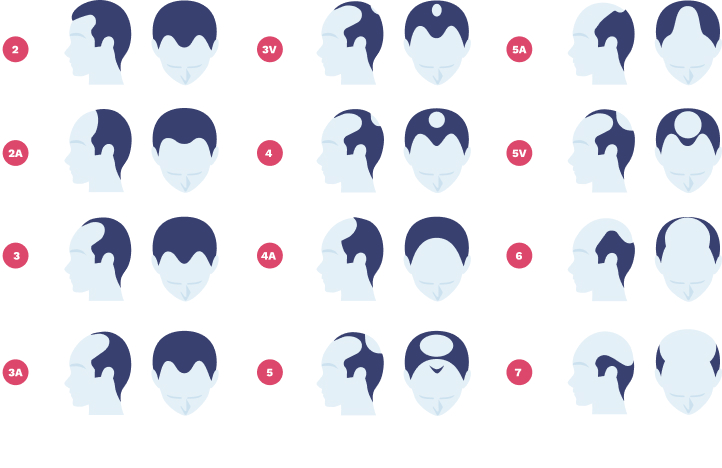Men’s Hair Loss
Androgenetic alopecia, also known as common male pattern baldness (MPB), is responsible for over 95% of hair loss in men. By the age of thirty-five, two-thirds of American men will experience some degree of noticeable hair loss, and by the age of fifty, approximately 85% of men will have significantly thinning hair. Around 25% of men with male pattern baldness begin losing hair before the age of twenty-one.
Introduction
Contrary to popular belief, most men who suffer from male pattern baldness are extremely unhappy with their situation and would do anything to change it. Hair loss affects every aspect of a sufferer’s life, from interpersonal relationships to professional opportunities. In fact, the American Hair Loss Association (AHLA) has received countless reports from young men who felt so overwhelmed and distracted by their progressive hair loss that they were forced to change their career paths.
Recognizing the devastating impact of male pattern baldness on men of all ages, the AHLA has created resources to provide objective answers to hair loss questions. We strongly advise against relying on commercial websites and social media platforms for information, unless they carry the AHLA seal or the AHLA Trusted Content Creator distinction. Many products and services being sold online to vulnerable hair loss consumers are not backed by scientific evidence. Currently, only two FDA-approved products have been clinically proven to stop or prevent hair loss, and only a relative handful of surgeons are performing surgical hair restoration to state-of-the-art standards.
In addition to male pattern baldness, this section will also discuss other forms of alopecia that can affect a smaller subset of people. The AHLA is dedicated to providing comprehensive information and education to support men who are experiencing hair loss, empowering them to make informed decisions during their hair loss journey.
Diagnosis
Typical male pattern baldness is usually diagnosed based on the appearance and pattern of the hair loss, along with a detailed medical history, including questions about the prevalence of hair loss in your family. An experienced medical hair loss expert should examine the scalp under magnification (preferably with a device called a densitometer), in order to assess the degree of miniaturization of the hair follicles. This can help determine if the hair loss is consistent with male pattern baldness.
In some cases, if the physician suspects another form of alopecia or if the hair loss appears to have a diffuse pattern, they may suggest a scalp biopsy to confirm the diagnosis. Scalp biopsy involves taking a small sample of the scalp tissue for microscopic examination to determine the cause of hair loss. However, in general, the diagnosis of male pattern baldness is relatively straightforward based on the characteristic pattern of hair loss.
It’s important to note that some advertised “clinics” may recommend costly hair analysis or scalp biopsy as part of their diagnostic process, but these may not be necessary for typical male pattern baldness. The only reason to have a hair analysis is to assess the possibility of poison-induced hair loss, which is rare. Hair analysis may reveal substances such as arsenic or lead, but hair loss caused by poisoning does not typically present itself in a typical male pattern. It’s important to seek the advice of a qualified physician who can properly examine and diagnose your hair loss, and avoid unnecessary and costly tests or procedures.
The Norwood Scale
The Norwood Scale, also known as the Norwood-Hamilton Scale, is a widely used classification system for male pattern baldness.
The Norwood Scale was first introduced by Dr. James Hamilton in the 1950s and later modified by Dr. O’Tar Norwood in the 1970s. The Norwood Scale provides a visual representation of the various stages of male pattern baldness, which can help individuals understand the extent of their hair loss and communicate it to physicians or practitioners during consultations, whether in person or remotely.
The Norwood Scale categorizes male pattern baldness into seven stages, ranging from Stage I (minimal to no hair loss) to Stage VII (extensive hair loss with only a narrow band of hair remaining on the sides and back of the scalp). The scale takes into account the pattern and extent of hair loss, including receding hairline, thinning crown, and overall hair density. It provides a standardized way to assess the progression of hair loss and helps clinicians determine the appropriate course of treatment.
Understanding the stage of hair loss according to the Norwood Scale can be helpful in selecting the most appropriate treatment options. For example, individuals in the earlier stages (Stage I-III) may benefit from medications such as minoxidil or finasteride, while those in the later stages (Stage IV-VII) may require more advanced treatments including hair transplant surgery if they make proper candidates. By knowing the stage of their hair loss on the Norwood Scale, individuals can better communicate their condition to healthcare providers and make informed decisions about their treatment options.

It’s important to note that while the Norwood Scale is a widely used and accepted classification system for male pattern baldness, there are other variants and patterns of hair loss that may not fit exactly into the scale. Therefore, a proper diagnosis should be made by a qualified healthcare provider, taking into consideration individual factors such as medical history, family history, and other relevant information. Avoid self-diagnosis and consult with a healthcare professional for accurate assessment and appropriate treatment options for your specific hair loss condition.